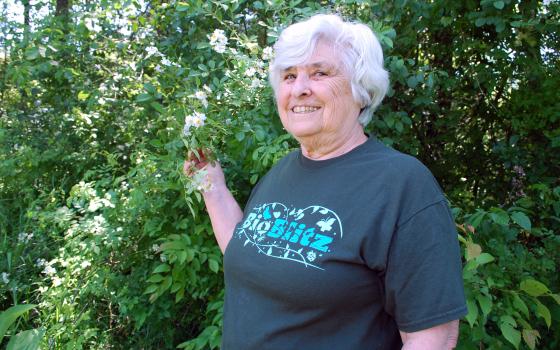The 39-acre Mercy Farm in Benson is home to at least 36 moth species, more than two dozen types of trees, a half dozen spore bearer varieties, two score of plants, 42 types of birds, a dozen insects and a dozen animals, eight types of aquatic life and three Sisters of Mercy.
It's easy to count the sisters who live at the eco-spiritual center but difficult to count the other forms of life there.
But thanks to a recent "BioBlitz," the sisters have a better handle on just what is living with them on the religious congregation's property.
The BioBlitz was a 24-hour period of intense biological surveying in May to attempt to record all the living species on the farm.
According to Sr. Betty Secord, program director, the survey was valuable in showing how full of life the land is and how connected each form of life is to others. "The desire came from our sense that we are connected. All of creation is interconnected," she told Vermont Catholic, the Diocese of Burlington's publication.
According to the Mercy Farm website, "Spiritual practice invites us to contemplate and engage in the world in an intentional way that is dedicated to developing a more insightful, mature relationship with self and the world — a way that is profoundly meaningful and fulfilling."
During this Year of Creation in Vermont called for by Burlington Bishop Christopher Coyne, the BioBlitz drew attention to the need to care for all of God's creation.
"If we're all part of creation, all part of God's gift of love through nature, when one part of our body hurts, we all hurt," said Secord, director of the BioBlitz at Mercy Farm. "Everything is a manifestation of God's love."
But she lamented that much of society has become "consumers" rather than "citizens," disconnected from creation. "We are raping the earth for comfort and profit," she said. "We are not living within our means. We are consuming too fast for the earth to recoup. We are taking much more than we actually need. Consumerism is a major issue."
So at Mercy Farm, visitors can connect with one another, with nature and with their deepest self. "It's important that we have places like this in the world where people can get away from everyday life and get that sense of relationship," Secord said.
It's also a place where, according to the BioBlitz, visitors just might see a clover looper moth, a quaking aspen, a prickly ash, an inky cap, a hairy vetch, an ox-eye daisy or a dog violet.
There also will be wild geraniums, robins, crows, June bugs, caterpillars, fox, red maples and crayfish.
Forty-two volunteers and 30 participants attended the BioBlitz, recording their findings in categories including trees, basic botany, spore bearers, animal signs, insects, moths, aquatic life and birds. A group of naturalists led the effort.
No recommendations for improvements to the farm's ecosystem were made. "They seemed to think we have a complete ecosystem here," Secord said of the experts.
She plans to share the information from the BioBlitz with visitors and said it will be important information for future planning for the property.
The BioBlitz also included a master gardener display, an astronomy talk, a lesson on growing mushrooms, a bat-banding demonstration and a scavenger hunt.
